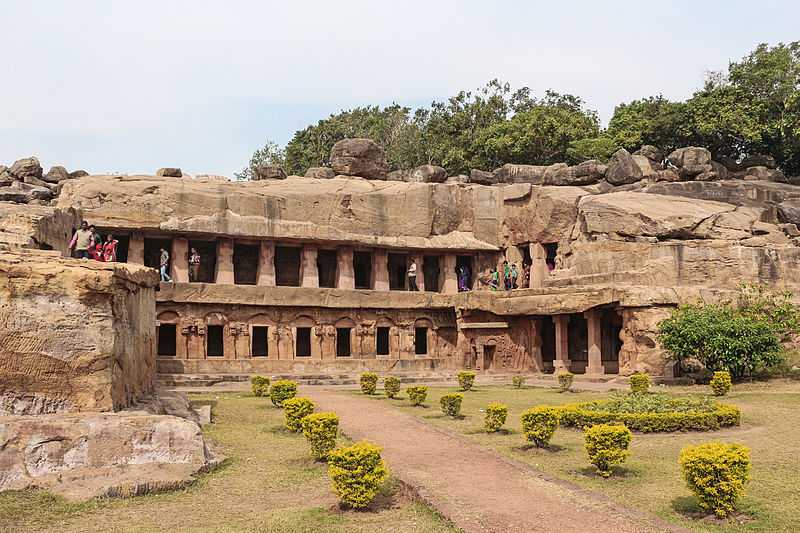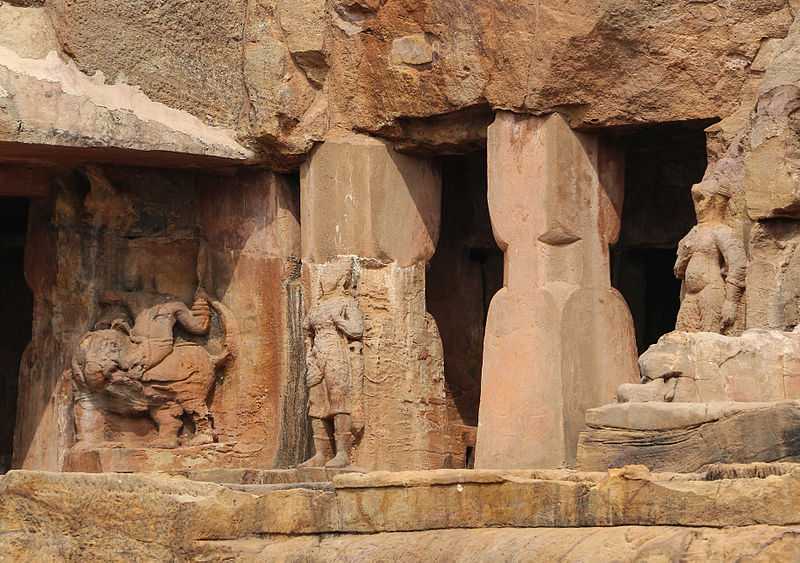Udayagiri Caves Travel Essentials
Rating:
Weather:
Ideal duration: 1-2 days
Best Time: October-March Read More
Planning a Trip? Ask Your Question
"Rock-cut Caves in the Heart of India"
Udayagiri Caves Tourism
'Udayagiri' means the mountain of the sunrise, and is a historical Hindu ritual site home to twenty rock-cut caves near Vidisha, Madhya Pradesh. Otherwise known as 'Vishnu Padagiri' meaning "the feet of Vishnu", the Udayagiri Caves are extensively carved with iconographies of Hindu Gods, namely Vishnu, Durga and Shiva containing legendary stories of the gods and their shrines. Udayagiri hills hold twenty caves dedicated to Hinduism and Jainism sculptures from the Gupta Era. Among which the most prominent one is the fifth cave which is famous for the ancient monumental statue of Lord Vishnu in his incarnation as the Boar-Headed Varaha rescuing Bhudevi (earth).
The passage starting beside cave eight is another unique feature of Udayagiri. It consists of a natural canyon that runs from east to west of the cave. Although the passage has been subject to modifications, the set of steps carved onto the floor is a significant attribute of the caves. The locale has substantial inscriptions of the Gupta Dynasty reigned by Chandragupta Maurya. This 5th-century monument is home to rock shelters, petroglyphs, epigraphs, fortifications which are all subject to the Archeological Survey India.
Top Hotels In Udayagiri Caves
More on Udayagiri Caves Travel
Description of the Udayagiri Caves
The Udayagiri Caves are a total of 20 in number, which have been divided on the basis of religious sects. Seven of these have been dedicated to Shaivism, nine to Vaishnavism, and three to Shaivism. While some of these caves have inscriptions, and some have sculptures, the caves numbered 1, 3, 4, 6 and 13 have the most number of sculptures and inscriptions. And Cave numbered 19 is the largest of them all. Besides, these caves have rock-cut water tanks, and some have shrines and monuments on top.

- Cave 1 is the southernmost cave which is also considered to be a false cave since the side and the front was added later on. There are four pillars and the back wall has a deity carved onto it.
- Cave 2 is located north to the Cave 1 but is still in the southern group and has traces of two pilasters. And there is also evidence of a structural mandapa underneath its roof.
- Cave 3 is the first ones of the central group of caves. With a plain entrance and sanctum, there is also a mandapa in front of the shrine and a rock-cut image of the war God- Skanda. Although most part of the cave and the temple is ruined and all of it sits there like a huge desecrated mess but it still displays some impressive remnants. The cave is sometimes also called the Skanda Temple.
- Cave 4 represents both Shaiva and Shakti themes. It has a plain but impressive doorway. One of the frames on the doorway represents a man playing the flute while the other side has a man playing the guitar. These are also flanked by the river goddesses Ganga and Yamuna. The main sanctum is dedicated to Lord Shiva and is enshrined by a Shivalinga with a face carved on it. The mandapa has been eroded but there have been remnants of matrikas (mother goddesses) found here. This is also one of the three sites where these matrikas are found in the Udayagiri Caves.
- Cave 5 is less like a cave and more like a niche with an elaborate Varaha panel with its narrative where Varaha or the man-boar rescuing the Goddess Earth. The panel has elaborate description of the turns and events about how the Goddess was rescued.
- Cave 6 has a T shaped door and a rock-cut sanctum. The door had guardians and images of Vishnu and Shiva Gangadhara. It also has the representation of Goddess Durga slaying Mahishasura. Besides, there is also a figure of Lord Ganesha seated with modaks and a trunk. On the right side of Vishnu, you can find another group of the matrikas (mother goddesses). An inscription in the Cave mentions that it is Gupta year 82 (401 CE).
- Cave 7 is again a large niche with engraved figures of eight Mother Goddess in the back of the cave. Each of these figures holds a weapon over their heads. There are also faintly visible images of Kārttikeya and Gaṇeśa.
- There is a Passage right after Cave 7 running east to west like a cleft or a canyon. There are steps cut out which have now been eroded due to weathering. They also have inscriptions and shell inscriptions which have not been deciphered yet.

Source - Cave 8 is called the “Tawa Cave” because it looks like the “tawa”- which is the Indian equipment on which the local bread (or roti) is baked. Although in ruins, the cave has evidence and traces of a mandapa. The most notable element of the cave is its 4.5 feet (1.4 m) lotus carving on the top ceiling.
- Caves 9 - 11 are all small excavations next to each other near Cave 8. It has damaged Vishnu carvings and the doors all open north- northwest. Cave 11 is the biggest of the three.
- Cave 10 is a Vaishnavism cave which is known for its figure of Narasimha- the man-lion avatar of God Vishnu. It also suggests, rather it provides clear evidence that it was excavated into a rock with pre-existing inscriptions. These inscriptions are in Sankha Lipi and although it is not deciphered yet it suggests that the place was inhabited and occupied by literal people before the creation of these caves.
- Cave 13 has an elaborate panel of Anantasayana with a depiction of Lord Vishnu. Underneath the figure of Vishnu are two men. It is suggested that one of these men kneeling to God is the king Chandragupta II himself while the other one is his minister Virasena.
- Cave 14 is the last cave in this group. It has a small square recess chamber, with only two of its sides preserved. Caves 15 - 18 are a bunch of small square caves that are distinct from each other mostly in design.
- Cave 15 doesn’t have a separate sanctum and pitha. Cave 17 is known for its Ganesh image and also its Goddess Durga in her Mahishasura-mardini form. The ceiling has a symmetric pattern of lotus on the ceiling. Cave 18 is notable for its four-armed Ganesha.
- Cave 19 is the largest cave in the lot and is also known as the “Amrita Cave”. It has several pillars with carvings of four-horned and winged creatures. The doorway is more elaborately ornamented than the other caves’. It is believed to have a much larger temple with a mandapa but is currently in ruins. There are elaborate narratives of the Goddesses Ganga and Yamuna, and also stories from the Hindu mythology carved on the walls of the cave. It also houses two Shiva Lingas.
- Cave 20 is the single cave in the group that has been dedicated to Jainism. Located towards the northwest side, the cave has a figure of the Jain tirthankara Parshvanatha sitting under a serpent hood, near the entrance. The interiors have been divided into 5 different rooms. Besides, it has inscriptions about the Gupta Kings. It also has other features like Jina reliefs which have carvings of the chattras carved atop them.
Best Time to Visit Udayagiri Caves
Nearby Places
FAQs on Udayagiri Caves
What is the best time to visit Udayagiri caves?
Read More
What are the places near Udayagiri caves?
Have a Question on Udayagiri Caves?

experience.
Udayagiri Caves Reviews


Prashant Lowanshi
3 years ago